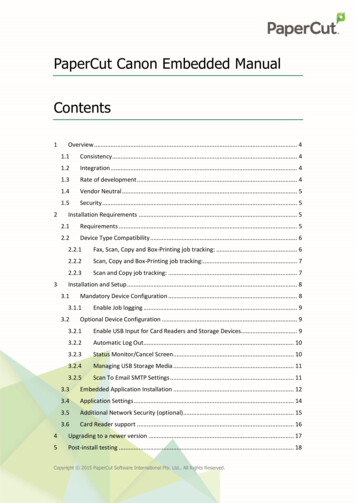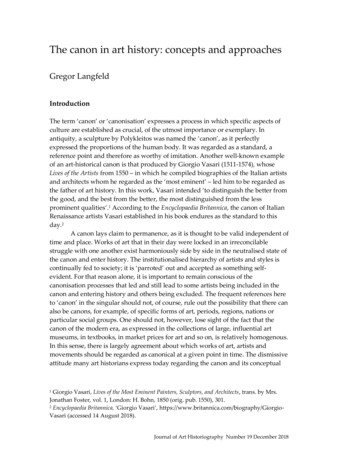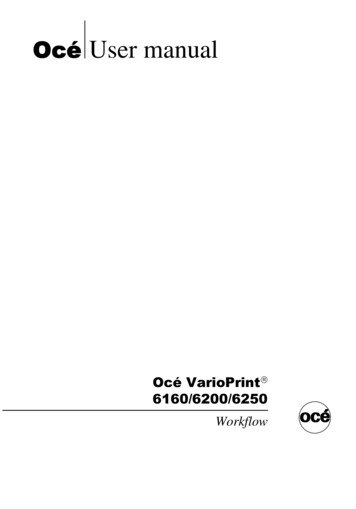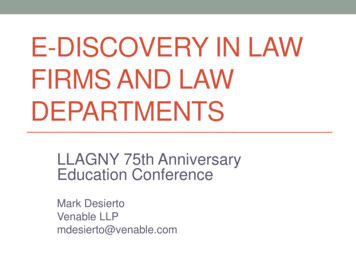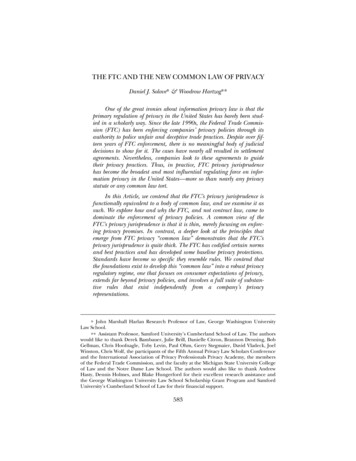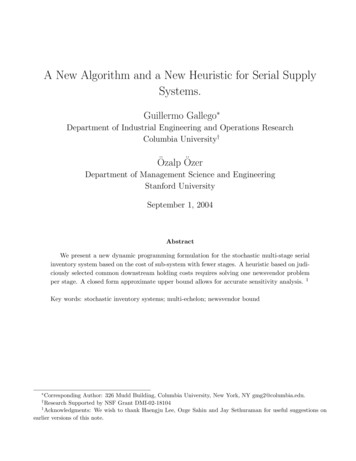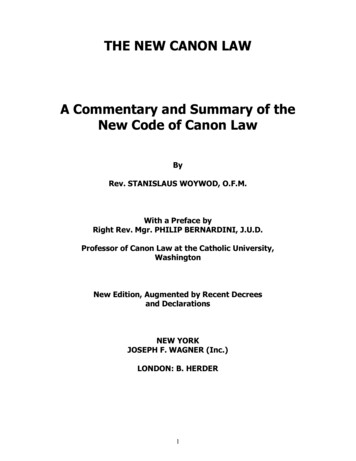
Transcription
THE NEW CANON LAWA Commentary and Summary of theNew Code of Canon LawByRev. STANISLAUS WOYWOD, O.F.M.With a Preface byRight Rev. Mgr. PHILIP BERNARDINI, J.U.D.Professor of Canon Law at the Catholic University,WashingtonNew Edition, Augmented by Recent Decreesand DeclarationsNEW YORKJOSEPH F. WAGNER (Inc.)LONDON: B. HERDER1
FR. BENEDICT BOEING, O.F.M. FR. BENEVENUTUS RYAN, O.F.M.FR. EDWARD BLECKE, O.F.M.Minister Provincialis JULY 1, 1918ARTHUR J. SCANLAN, S.T.D.Censor LibrotumImprimaturJOHN CARDINAL FARLEYArchbishop of New YorkNEW YORK, JULY 3, 1918Copyright, 1918, by JOSEPH F. WAGNER, New York2
PREFACEFor several months past the articles by Father Stanislaus Woywod in the Ecclesiastical Review haveinformed the clergy of the most important features of the new Code of Canon Law. The same author nowgives to the public a Summary and Commentary of the whole Code. As the present volume is publishedmainly with a view of the needs of the clergy engaged in the care of souls, the bulk of the book has beenkept as compact as possible; wherefore in such places only where explanation and comment seemednecessary they have been given, and in as brief a form as possible. Chapters which are not needed by everypriest have been mentioned only with few words and en passant, as it were. The fourth and the fifth Bookhave been summed up very briefly, giving the most important points of legislation contained therein. A verycomplete Index will make it easy to find any desired point of law.We heartily congratulate Father Woywod on the good work and trust that the clergy of the UnitedStates will be pleased to find in this volume a welcome means of acquiring the necessary knowledge of thenew legislation of the Church.Dr. PHILIP BERNARDINIProfessor of Canon Law at the Catholic University Washington, D. C.3
INTRODUCTIONWhen on May the twenty-seventh, 1917, a new Codex Juris Canonici was promulgated by Papal Bull,this memorable event marked the happy conclusion of a revision of the Code of Law for the Catholic Churchwhich had taken thirteen years of the most painstaking work on the part of a large number of erudite scholarsand specialists in Canon Law. The new Code is truly a monumental work, the magnitude of which will beapparent when thought is given to the truly gigantic task of revising and coordinating all the existing Churchlaws, including the laws of all ages since the times of the primitive Church, eliminating all those that havedropped out of use, or that have been revoked or suspended in the course of the centuries. Never before inthe history of the Church was such a compilation on the same immense scope attempted. During the MiddleAges various Popes caused official collections made of laws that had been enacted within a limited period ofyears, but never before was the entire legislation of the Church unified and codified as it has now been donein the new Codex.The Papal Bull decreed that the new book of law was to go into effect on Whitsunday, May thenineteenth, 1918. The period of time allowed before a new law after its official promulgation goes into force isknown in the terminology of Canon Law as the vacatio legis. Canonists have generally held that for all lawspromulgated by the Holy See two months' time is granted before in places outside the City of Rome theobligation of observing the law begins. For very remote countries even a longer time has been conceded, inorder to let the knowledge of the law become sufficiently disseminated to make its enforcement possible. Inmore recent times the Holy See has in important laws frequently specified the period of the vacatio legis, asfor instance in the case of the decree Ne Temere which was published about eight months before it was tobe enforced. The general principle, however, valid in civil law as well as in Canon Law, is that it is the duty ofsubjects to keep themselves informed through the ordinary channels of information, as, for instance, officialmagazines and papers, what laws, amendments, decisions, etc., have been enacted by the authorities. It isnot necessary, hence, that the bishop announce to his clergy the laws and regulations passed by thesupreme authority of the Church, nor can it be said that this is his duty, though for uniformity of action on partof the clergy of a diocese it is advantageous that the bishop announce to his priests the important new lawswith direction to make them known on one and the same day to the people throughout the diocese.The purpose of the new Codex is, to supersede all existing collections of papal laws, whethercontained in the various official compilations published with the special approval of former Popes, or in thevolumes of decrees and declarations published by the various Roman Congregations, or, finally, in the manyexisting private collections of papal laws. Only in those instances in which the new Code expressly declaresthat a former law on a specified subject is to be retained, are former laws to continue in force. Instances ofthis kind are discussed in the course of the present volume.The benefit of the new Code is inestimable, and it will go far toward unifying and strengthening theactivities of the Church, by effecting a more uniform course of action in all the important details of theChurch's life. Let no one, however, labor under the impression that the Code means the legislation of theSupreme Head of the Catholic Church has now come to an end. An organization like the Catholic Church,living and laboring in the great, wide world, and guiding millions of people of all races in the way of truth,must needs adapt her work to the ever-changing conditions of peoples and times. The present Code,therefore, is not, and cannot be, the final law in all and everything, for, in as much as Canon Law is theregulation of the activities of the Church, and since these activities are changing and developing with thegradual progress of civilization, new amendments, decisions, declarations concerning the meaning of someof the laws, and exceptions and particular regulations to fit the exceptional conditions of particular countriesor dioceses, must naturally be expected. The Holy Father has, however, provided (Motu Proprio, Sept. 15,1917; Ada Ap. Sed., vol. IX, pag. 483) that any and all new laws, as well as the possible repeal of someCanons of the new Code, also any interpretative declarations, etc., issued either by the Supreme Pontiffhimself or by one of the Sacred Congregations, shall be turned over to a committee whose duty it will be toformulate the new laws, etc., into Canons, and to insert them in the Code in their proper places, so that theCode may for all times remain the one, authoritative and complete lawbook of the Church.The canonist will note the difference in the arrangement of matter in the new Code from the orderfollowed in former collections of Canon Law. Previous collections were, as a rule, divided into five books, inthe order of: judex, judicium, clerus, connubia, crimen, whereas the five books of the present Code are: Lib.I., Normae generates; Lib. II., De Personis; Lib. III., De Rebus; Lib. IV., De Processibus; Lib. V., De Delictiset Poenis. Reference to the laws has been made easy by short Canons, or paragraphs, numberedconsecutively from beginning to end of the Code, two thousand four hundred and fourteen Canons in all, sothat the number of the Canon suffices to enable one to find a certain law, no matter in what book, or underwhat title, this law may be placed.4
The purpose of our present volume on the new Code is, mainly, to give the clergy engaged in parishwork in a handy volume all that which is of practical importance for them in their daily life, in the exercise oftheir sacred duties that must be guided by the laws of our Holy Mother Church. Prolonged discussion andlengthy comparison wrth former law, such as might appeal to the student who has no other duties but hisstudies to attend to, are avoided in this volume. Such discussion and comparison will find proper place in acomplete and thorough Commentary on the Code which the author has under consideration for futurepublication.In arranging the subject-matter of this book we have faithfully adhered to the order of the new Code, indeference to the Holy Father's desire that no one introduce an arrangement differing from the Code.THE AUTHOR.On the Feast of St. Bonaventure, D.S., July 14, 1918.5
CONTENTSPAGEPREFACEINTRODUCTIONTHE FIRST BOOK: GENERAL PRINCIPLES OF CANON LAWTitle I Principles of Ecclesiastical Laws 3Title II Customs 7Title III Manner of Reckoning Time 8Title IV Rescripts 10Title V Privileges 13Title VI Dispensations 15THE SECOND BOOK: LAWS CONCERNING PERSONS 17PART I: LAWS CONCERNING THE CLERGYSection I The Clergy in General 22Title I Manner of Ascribing the Clergy to a Diocese 22Title II The Rights and Privileges of Clerics 23Title III Obligations of Clerics 25Title IV Ecclesiastical Offices 29Title V Ordinary and Delegated Jurisdiction 30Title VI Reduction of Clerics to the State of the Laity 34Section II Clerics Individually 35Title VII The Supreme Authority and Those who by Law Share in it 36Chapter I The Roman Pontiff 36Chapter II The General Council 37Chapter III The Cardinals of the Holy Roman Church 38Chapter IV The Roman Curia 41Article I The Roman Congregations 42Article II The Tribunals of the Roman Curia 46Article III Offices of the Roman Curia 46Chapter V Legates of the Roman Pontiff 47Chapter VI Patriarchs, Primates, Metropolitans 48Chapter VII Plenary and Provincial Councils 49Chapter VIII Vicars and Prefects Apostolic 51Chapter IX Administrators Apostolic 51Chapter X Inferior Prelates 52Title VIII Episcopal Jurisdiction and Participants of the Same 53Chapter I Bishops 53Chapter II Coadjutors and Auxiliary Bishops 59Chapter III The Diocesan Synod 61Chapter IV The Diocesan Curia 62Article I The Vicar General 63Article II The Chancellor, Other Notaries, the Episcopal Archives. 65Article III Synodal Examiners and Parochial Consultors 67Chapter V Chapters of Canons 68Chapter VI Diocesan Consultors 68Chapter VII Obstruction in the Government, Vacancy of the Episcopal See, the Vicar Capitular 69Chapter VIII Deans 72Chapter IX Pastors 74Chapter X Parochial Vicars 80Chapter XI Rectors of Churches 83PART II: THE RELIGIOUS 85Title IX Erection and Suppression of a Religious Organization, of a Province, or a House 87Title X The Government of Religious Organizations 89Chapter I Superiors and Chapters 89Chapter II Confessors and Chaplains 94Chapter III Temporal Goods and Their Administration 98Title XI Admission Into a Religious Community: 100Chapter I Postulate 1016
Chapter II Novitiate 101Article I Conditions for Admission 101Article II Education of the Novices 106Chapter III Religious Profession inTitle XII Studies in Clerical Religious Communities 115Title XIII Duties and Privileges of Religious 117Chapter I Duties 117Chapter II Privileges of the Religious 122Chapter III Duties and Privileges of a Religious Promoted to anEcclesiastical Dignity, or to Rectorship of a Parish 124Title XIV Transition to Another Order 127Title XV Departure from Religious Life 128Title XVI Dismissal of Religious 131Chapter I Dismissal of Religious with Temporary Vows 131Chapter II Dismissal of Religious with Perpetual Vows in Nonexempt Clerical and in All LaicalOrganizations 132Chapter III The Canonical Trial in the Dismissal of Religious with Perpetual or Solemn Vows in aClerical Exempt Religious Organization 134Chapter IV Dismissed Religious Who Had Taken Perpetual Vows. . 136 Title XVII Societies of Men orWomen Leading a CommunityLife Without Vows 138PART III: THE LAITY. 139Title XVIII GeneraJ Regulations for Associations of the Faithful. 140 Title XIX Particular Regulationsfor Associations of the Faithful. 143Chapter I Third Orders Secular 144Chapter II Confraternities and Pious Unions 145Chapter III Archconfraternities and Primary Unions 147THE THIRD BOOK: SACRED THINGS 149PART I: THE SACRAMENTS 150Title I Baptism 151Chapter I The Minister of Baptism 151Chapter II The Subject of Baptism 152Chapter III The Rites and Ceremonies of Baptism 154Chapter IV Sponsors 156Chapter V Time and Place of Baptism 157Chapter VI Recording and Proof of Baptism 158Title II Confirmation 159Chapter I The Minister of Confirmation 159Chapter II The Subject of Confirmation 160Chapter III Time and Place of Confirmation 161Chapter IV The Sponsors 161Chapter V Record and Proof of Confirmation 162Title III The Blessed Eucharist 162Chapter I The Holy Sacrifice of the Mass 163Article I The Celebrant 163Article II The Rites and Ceremonies of Holy Mass 165Article III Time and Place of Holy Mass 165Article IV The Alms or Stipends of Masses 166Chapter II The Blessed Sacrament 170Article I The Minister of Holy Communion 170Article II The Recipient of Holy Communion 171Article III Time and Place for the Distribution of Holy Communion 174Title IV The Sacrament of Penance 175Chapter I The Minister of the Sacrament of Penance 175Chapter II Reservation of Sins 179Chapter III The Subject of the Sacrament of Penance 182Chapter IV The Place Where Confessions are Heard 183Chapter V Indulgences 183Article I Concession of Indulgences 183Article II Manner of Gaining Indulgences 186Title V Extreme Unction 188Chapter I The Minister of Extreme Unction 1887
Chapter II The Recipient of Extreme Unction 189Chapter III The Rites and Ceremonies of Extreme Unction 189Title VI The Sacrament of Orders 190Chapter I The Minister of Sacred Ordination 190Chapter II The Subject of Sacred Ordination 194Article I Requisites for Candidates of Ordination 194Article II Irregularities and Other Impediments 197Chapter III Requisites Prior to the Ordination 200Chapter IV The Rites and Ceremonies of Ordination 203Chapter V Time and Place of Ordination 203Chapter VI Record and Testimonial of Ordination 204Title VII The Sacrament of Marriage 205Chapter I Requisites Before Marriage and Especially the Banns 206Chapter II Impediments in General 209Chapter III Impedient Impediments 214Chapter IV Diriment Impediments 216Chapter V The Matrimonial Consent 219Chapter VI Form of the Marriage Contract 221Chapter VII The Marriage of Conscience 225Chapter VIII Time and Place of Marriage 226Chapter IX Consequences of Marriage 226Chapter X Separation of Married People 227Article I Dissolution of the Marriage Bond 227Article II Separation from Bed and Board 230Chapter XI Validation of Marriage 231Article I Simple Validation 231Article II Sanatio in Radice 232Chapter XII Second Marriage 233Title VIII The Sacramentals 233PART II: SACRED PLACES AND SEASONS 234Section I Sacred Places 234Title IX Churches 235Title X Oratories 242Title XI Altars 243Title XII Ecclesiastical Burial 245Chapter I Cemeteries 245Chapter II Transfer of the Body to Church, Funeral Services andInternment 247Chapter III Persons to Whom Ecclesiastical Burial Must Be Granted or Denied 253Section II Sacred Seasons 254Title XIII Holidays of Obligation 255Title XIV Fast and Abstinence 255PART III: DIVINE WORSHIP 257Title XV The Keeping and Cult of the Blessed Sacrament 259Title XVI The Cult of the Saints, of Sacred Images and Relics 262Title XVII Sacred Processions 265Title XVIII Sacred Utensils 266Title XIX Vow and Oath 269Chapter I Vow 269Chapter II Oath 270PART IV: THE TEACHING AUTHORITY OF THE CHURCH 272Title XX Preaching of the Word of God 273Chapter I Catechetical Instruction 273Chapter II Sacred Preaching 274Chapter III Sacred Missions 277Title XXI Seminaries 278Title XXII Catholic Schools 283Title XXIII Censorship and Prohibition of Books 285Chapter I Censorship of Books 285Chapter II Prohibition of Books ., 287Title XXIV Profession of Faith 290PART V: BENEFICES AND OTHER NON-COLLEGIATE INSTITUTES OF THE CHURCH 292Title XXV Ecclesiastical Benefices 2928
Chapter I Constitution or Erection of Benefices 293Chapter II Union, Transfer, Division, Dismembration, Conversion and Suppression of Benefices 294Chapter III Conferring of Benefices 298Chapter IV The Right of Patronage 298Chapter V Rights and Duties of Beneficiaries 299Chapter VI Resignation of Benefices 299Title XXVI Other Non-Collegiate Institutes of the Church 300PART VI: TEMPORAL GOODS OF THE CHURCH 301Title XXVII Acquisition of Ecclesiastical Goods 302Title XXVIII The Administration of Ecclesiastical Goods 306Title XXIX Contracts 309Title XXX Pious Foundations 312THE FOURTH BOOK: CANONICAL TRIALS 315PART I: PROCEDURE IN COURT 315Section I Trials in General 316Section II Special Rules to be Observed in Certain Specified Trials. 316Title XVIII Manner of Avoiding Canonical Trial 316Chapter I Transaction 316Chapter II Compromise by Arbitration 317Title XIX Criminal Trials 318Chapter I Accusation and Denunciation 318Chapter II Inquisition 319Chapter III Reprimand of the Delinquent 321Chapter IV Construction of the Criminal Trial and Summons ofthe Offender 322Title XX Matrimonial Cases 323Chapter I Competent Forum 323Chapter II Constitution of the Tribunal 324Chapter III Right to Accuse a Marriage and to Ask the Dispensation from the Matrimonium Ratum 325Chapter IV Proofs 326Article I Witnesses 326Article II Bodily Inspection 326Chapter V Publication of the Trial, Conclusion of the Case, andSentence 327Chapter VI Appeals 328Chapter VII Cases Excepted from the Foregoing Rules 329Title XXI Cases Against Sacred Ordination 330PART II: CASES OF BEATIFICATION OF THE SERVANTS OF GOD AND CANONIZATION OF THEBLESSED 331PART III: THE MANNER OF PROCEDURE IN CERTAIN AFFAIRS OR IN THEAPPLICATION OF PENAL SANCTIONS 331Title XXVII Manner of Procedure in the Removal of IrremovablePastors 333Title XXVIII Manner of Procedure in Depriving Removable Pastors of Their Parish 335Title XXIX Manner of Procedure in the Transfer of Pastors 336Tide XXX Manner of Procedure Against Clerics Not Observing the Law of Residence 337Title XXXI Manner of Procedure Against Clerics Living in Concubinage 339Title XXXII Manner of Procedure Against a Pastor Who is Negligent in the Fulfilment of the PastoralDuties 340Title XXXIII Manner of Procedure for Infliction of the Suspension Ex Informata Conscientia 340THE FIFTH BOOK: OFFENCES AND PENALTIES 343PART I: OFFENCES 343Title I Nature and Division of Offences 343Title II Imputability of an Offence, Causes Which Aggravate orDiminish It, and Juridical Effects of an Offence 344Title III Attempted Crime 347PART II: PENALTIES 348Section I Penalties in General 348Title IV Definition, Species, Interpretation and Application ofPenalties 348Title V Superiors Having Coercive Power 3509
Title VI Persons Subject to the Coercive Power 352Title VII Pardon of Penalties 355Section II Penalties in Particular 356Title VIII Corrective Penalties of Censures 356Chapter I Censures in General 356Chapter II Censures in Particular 361Article I Excommunication 362Article II Interdict 365Article III Suspension 367Title IX Punitive Penalties 370Chapter I Common Punitive Penalties 371Chapter II Punitive Penalties Special to the Clergy 373Title X Penal Remedies and Penances 375Chapter I Penal Remedies 375Chapter II Penances 377PART III: PENALTIES FOR INDIVIDUAL CRIMES 377Chapter I Penalties Incurred Ipso Facto (Laiae Sententiae) 378Chapter II Penalties Ferendae Sententiae 385APPENDIX: New Decrees and Declarations regarding the ELECTIONS IN RELIGIOUS ORDERS;FACULTIES OF BISHOPS; etc 42310
THE FIRST BOOKGeneral Principles of Canon Law1. It is stated in the first Canon of the Code that its laws are obligatory only for Catholics of the LatinRite, except in those points which of their very nature affect also the Oriental Church. This ruling is not new,it has obtained for many centuries. On account of the great difference in manners and customs between thepeoples of the East and those of Europe, and of countries christianized by missionaries of the Latin Rite, theHoly See wisely modifies for the Oriental Church some laws in accordance with requirements. A specialCongregation for the Orientals has been established at Rome to regulate the affairs of the Catholics of thevarious Oriental Rites. The laws on points of faith and morals, however, of their very nature bind all Catholicsin union with the See of St. Peter, for in principles of faith and morals all who wish to be members of theCatholic Church can acknowledge but one guide, viz., the infallible teaching authority of the Supreme Pastorand his colleagues, the bishops, in unison with their head. (Canon 1.)2. All liturgical laws heretofore decreed for the celebration of Holy Mass, for the Divine office and othersacred functions, retain their force, except those that are explicitly corrected in the Code. (Canon 2.)3. Special agreements or concordats made between certain nations and the Holy See are notchanged by the Code. (Canon 3.)4. Acquired rights, privileges and indults which have been granted by the Holy See to individuals ororganizations, if they are still in use and have not been revoked, remain in force unless they are explicitlyabrogated in the Code. (Canon 4.)5. Now existing immemorial customs, both particular and universal, at variance with these Canons areabolished if the Code explicitly disapproves of them. Centenary and immemorial customs not disapproved bythe Code may be tolerated, if the bishop judges that they cannot prudently be abolished. Customsdisapproved by the Code are to be considered corruptions of the law and can never in future revive andobtain the force of law. Ordinary customs at variance with the laws of the Code are to be consideredsuppressed, unless the Code explicitly states otherwise. (Canon 5.)6. 1. As regards laws published prior to the Code, the general rule is that all former laws, whetherparticular (for instance, for a certain country, for a Religious Order, etc.) or universal, that conflict with thelaws of the Code, are abolished, unless the Code explicitly rules otherwise in reference tc any special law.(Canon 6, 1.)2. Canons of the Code that restate former laws exactly as they were before, must be interpretedaccording to the approved and accepted interpretation of commentators on the old law. Canons which agreeonly in part with the former law are to be interpreted like the former law in the points in which they agree; butin the points in which the new law differs from the former they must be judged by their wording and context.When it is doubtful whether a law of the new Code differs from the old law, one must not deviate from theformer law. (Canon 6, 2, 3, 4.)3. All former ecclesiastical punishments, whether spiritual or temporal, corrective or punitive, latae orferendae sententiae, of which the Code makes no mention, are held to be abolished. (Canon 6, 5.)4. All other disciplinary laws which have been in force up to the present time cease to be binding,unless they are explicitly or implicitly contained in the Code. The laws contained in the approved liturgicalbooks, however, remain in force. This part of the Canon refers to the common law of the Church, for theCode states in Canon 22 that particular laws, namely for dioceses, individual countries, Orders, are toremain in force unless they are opposed to the laws of the Code. (Canon 6, 6.) (By declaration of the S.Congregation of the Holy Office, March 22, 1918, the rules and regulations concerning the oath againstModernism prescribed by Pope Pius X., of happy memory, are to remain in force until such time when theHoly See shall otherwise ordain. Ada Apost. Sedis, vol. X, pag. 136.)7. By the term "Apostolic See" or "Holy See," wherever it occurs in the Code, is meant not only theRoman Pontiff but also, unless the context proves the contrary, the Sacred Congregations, the RomanTribunals and Offices, through which the same Roman Pontiff does usually transact the affairs concerningthe universal Church, (Canon 7.)TITLE I.Principles of Ecclesiastical Laws.8. The laws are instituted when they are promulgated. A law is not presumed to be personal but ratherterritorial unless the law indicates that it is to be considered personal. In the common law of the Church it11
makes little difference whether a law is personal or territorial, but in particular laws for dioceses or countriesthe distinction is important for the reason that the law, if territorial, does not bind outside the limits of thediocese or country. (Canon 8.}9. The laws issued by the Holy See are promulgated by being published in the official magazine of theHoly See, the Acta Apostolicae Sedis, unless a special mode of promulgation should be prescribed in specialcases. The laws do not begin to bind in conscience until three months from the date of the number of themagazine containing the law have elapsed, unless the nature of the law is such that its immediateenforcement is evident, or the law itself should provide a longer or shorter period of "vacation." (Canon 9.)10. Laws concern future actions and not those done before the law was made, unless they makespecial mention of past actions. (Canon 10.).11. Those laws only are to be considered invalidating or inhabilitating which explicitly or equivalentlystate that an action is null and void, or that a person is incapable of acting. (Canon 11.)12. Unbaptized persons are not held to laws which are purely Church laws, nor baptized persons whohave not a sufficient use of their mind, nor children under seven years of age though they may havesufficient knowledge and judgment, unless the law does in some instances declare the latter to be held to itsobservance. (Canon 12.) The word purely is to be emphasized in this Canon, because laws which are anexplanation or application of the natural or the positive Divine law bind every human being as soon as thereis sufficient understanding of the law and consequent responsibility, apart from any definite age. Whereforealso the Committee for the Interpretation of the Code answered the Bishop of Valleyfield, January 3, 1918,that children who had the sufficient use of their reason before seven years of age were held to make theirEaster duty even before they were seven vears of age. (Eccl. Review, March 1918, pag. 313.)13. The general laws of the Church bind all persons for whom they are issued anywhere in the world.Laws issued for a particular territory, e. g., a diocese or a nation, bind those persons who have a domicile ora quasi-domicile in that territory and actually live there. For those who are absent from their own place for awhile the following Canon provides. (Canon 13.)14. Those persons who have a domicile or quasi-domicile but are for a time staying in another placeare called in law "peregrini." They are not held to the observance of the particular laws of their own dioceseor country while absent unless the transgression of these regulations causes some harm in their own place,or in case the laws are personal. They are not held to the particular laws of the diocese or country in whichthey are travelling with the exception of those laws that concern public order or determine the formalities oflegal transactions. They are, however, bound to observe the general laws of the Church, even those thathave been abolished for their own place. Thus, for instance, an American travelling in Europe is bound toobserve the holidays of obligation, fasts, etc., that may by papal indult have been abolished in America. Onthe other hand, the pcregrinus enjoys the dispensations from the general law in the country where heactually stays, even though there are no such dispensations granted to the diocese or country where heordinarily resides. Those who have neither a domicile nor a quasi-domicile in any place are called vagi. Theyare bound to observe both the general and the particular laws that are in force in the place where theyactually stay. (Canon 14.)15. All laws, even those that invalidate an action or inhabilitate a person to act, do not oblige in doubtof law (dubium juris); in a doubt of fact (dubium facti) the Ordinary may dispense, provided there is questionof laws from which the Roman Pontiff usually dispenses. (Canon 15.)16. No ignorance of invalidating or inhabilitating laws excuses unless the law explicitly admitsignorance as an excuse. Likewise ignorance or error is not presumed when it concerns the law or its penalty,or one's own action, or the notorious action of another; concerning the non-notorious action of another,ignorance is presumed until the contrary is proved. This rule applies mostly to cases where the delinquent isbrought to court for the transgression of a law. How far ignorance of the censure attached to the violation ofa law excuses is specified'in Canon 2229. (Canon 16.)17. Laws are authoritatively interpreted by the lawgiver and by those to whom the power of interpretinghas been committed. Authoritative interpretation of a law given in the form of law has the same force as thelaw itself. If such authoritative interpretation merely declares the meaning of the words of law that are certain,the interpretation does not need a new promulgation and reacts on past actions; if the interpretation restricts,or extends, the law or explains a doubtful point of the law, it does not react on past actions and is regardedlike a new law, so that it must be promulgated in order to have binding force. An interpretation of the lawgiven by way of a judicial sentence, or by a rescript in some special case, has not the force of law and bindsonly the persons and affects only those matters for which it was issued. (Canon 17.)18. Ecclesiastical laws must be interpreted according to the proper meaning of the terms of the lawconsidered in their context. If that meaning remains obscure, one must have recourse to parallel citations ofthe Code if there are any, or to the purpose and circumstances and the intention of the law-maker. (Canon18.)19. Laws that establish a penalty or restrict the free exercise of one's rights, or establish an exceptionfrom the law must be interpreted in a strict sense. It has always been an axiom of interpretation of CanonL
The Papal Bull decreed that the new book of law was to go into effect on Whitsunday, May the nineteenth, 1918. The period of time allowed before a new law after its official promulgation goes into force is known in the terminology of Canon Law as the vacat
